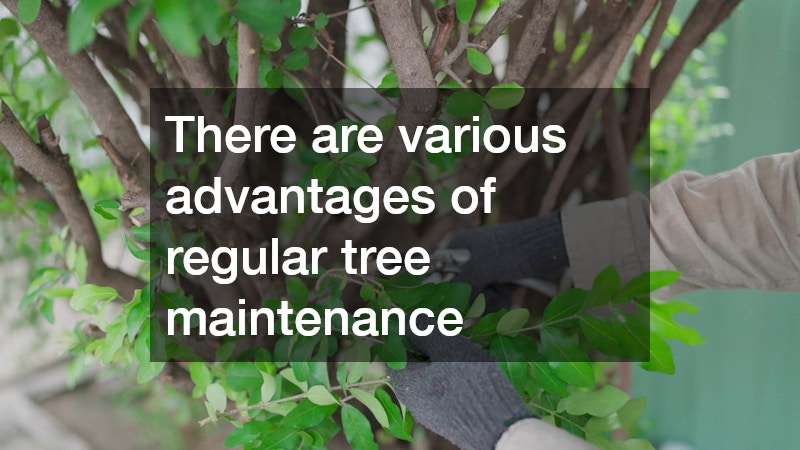The various services provided by your local tree company contribute to maintaining a healthy yard. Trees are a significant part of our environment, offering shade, beauty, and essential habitats for many species. However, just like any other plants, trees require regular care to thrive in your yard. Understanding the various aspects of tree maintenance can help you make informed decisions that benefit both your landscape and the ecosystem.
What Are the Benefits of Regular Tree Maintenance?
There are various advantages of regular tree maintenance, including health benefits for the trees and overall yard aesthetics. Regular maintenance helps to prevent disease and insect infestations, allowing your trees to grow healthier and live longer.
Healthy trees not only provide shade but also improve air quality and enhance the overall beauty of your yard. When your trees are well-cared for, they contribute positively to the aesthetic appeal of your entire property.
One of the primary benefits of regular tree maintenance is improved safety. Overgrown or unhealthy trees can pose a risk to your home and family due to falling branches or potential tree failure. By maintaining your trees through pruning and health assessments, you reduce the risk of accidents significantly. Investing in professional tree services ensures that your outdoor space remains safe and enjoyable for everyone.
Additionally, regular tree maintenance can increase your property’s value. Well-maintained trees and a healthy landscape create an inviting atmosphere that appeals to potential buyers. Homeowners who invest in tree care often report a higher return on investment when selling their properties. Trees can also provide energy savings by shading your home, leading to lower cooling costs during the warmer months.
How Do You Know When Your Trees Need Pruning?
It can be helpful to understand tips on identifying the signs that indicate a tree requires pruning and the optimal times for this service. Signs that your trees may need pruning include excessive leaf drop, dead or dying branches, and poor growth. If you notice any of these symptoms, it’s wise to consult with a tree care professional to assess the condition of your trees. Pruning not only enhances the structure of the tree but also encourages healthy new growth.
Optimal pruning times can vary based on tree species; however, late winter or early spring is often a good time for most trees as they prepare for the growing season. Pruning during dormancy minimizes the stress on the tree and promotes a burst of growth in the spring. It’s essential to follow recommended practices and timings to ensure the best outcomes for your trees.
Another crucial aspect of determining when to prune is assessing the tree’s health. If the tree is showing symptoms of diseases such as cankers or fungal infections, immediate pruning may be necessary to prevent the spread of disease. Regular assessments by professional arborists can keep your trees healthy and thriving, making timely interventions easier to manage.
What Types of Tree Services Do Professionals Provide?
There is a range of services offered by tree companies, such as tree trimming, removal, and health assessments. Tree trimming is perhaps the most common service offered by tree care professionals, allowing trees to maintain their shape and health. This service helps to remove surplus growth and dead branches, promoting better air circulation and sunlight penetration. Such practices lead to healthier trees and more vibrant foliage.
Tree removal is another significant service that professionals provide. If a tree has become dangerously unstable or is infested with pests, it may need to be removed for safety reasons. Proper tree removal requires the expertise of trained professionals to ensure that it’s done safely and effectively, preserving the surrounding landscape and preventing damage during the removal process.
Health assessments are also integral services provided by tree professionals. These assessments can help identify disease symptoms early on and recommend appropriate treatments. Regular health assessments ensure that your trees can thrive amid changing environmental conditions and help prolong their lifespan significantly. By staying proactive, you can ensure that your yard remains lush and green year-round.
How Often Should You Fertilize Trees?
Different types of trees have different fertilization needs. Learn the best practices to ensure healthy growth. Fertilization is an essential aspect of tree care that helps replenish nutrients in the soil, especially in urban environments where soil can be depleted. Different tree species have varying nutrient requirements, making it critical to know the specific needs of the trees in your yard.
Generally, a tree should be fertilized once or twice a year, depending on age, type, and health conditions. Young trees may require more frequent applications to support their rapid growth, whereas established trees might need less. Soil tests can provide insight into nutrient levels, helping you determine the proper fertilization schedule and type. Proper fertilization encourages robust growth and increases resistance to pests and diseases.
Additionally, applying fertilizer at the right time is crucial. Spring is typically the best time to fertilize as it coincides with the tree’s active growth phase. Using slow-release fertilizers can provide a steady supply of nutrients over time, which is beneficial to tree health. Engaging with a professional tree company can ensure that you use the correct fertilizer and application methods, providing your trees with the best chance to thrive.
Maintaining your yard’s health through professional tree care is essential. With the right services, your trees can thrive and contribute to a beautiful outdoor space. Regular maintenance not only enhances the safety and aesthetics of your property but also significantly increases the value of your home. By understanding how to care for your trees, you can create an environment that is both sustainable and enjoyable for years to come.



